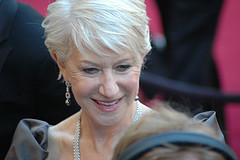Share This Article:
Return to Silver Screen Central Home page

B-The trailers for Woman in Gold, the fact-based drama about an elderly woman’s attempt to reclaim her family’s artwork that the Nazis stole in World War II, suggest that the movie is a legal thriller, Unfortunately, any lawyer can tell you that following the progress of a case, no matter how compelling the subject matter, as it makes its way through the legal system, is often as exciting paint dry. Indeed, that’s the main problem the movie faces.
Woman in Gold actually tells two stories. In one, an elderly Maria Altmann (Helen Mirren) hires an attorney (Ryan Reynolds) to help her reclaim paintings by Gustav Klimt that her Austrian family owned before World War II. After the Germans stole and later abandoned the paintings, they wound up on permanent display in a Vienna museum, widely regarded as national treasures. In the other story, a young Adele (Tatiana Maslany) sees the paintings taken and then barely escapes Austria alive, leaving her parents behind to meet their fate.
Despite most viewers’ familiarity with the subject matter through decades of other cinematic portrayals, Woman in Gold‘s flashback scenes have a power and immediacy that the more recent scenes lack. Simply put, Woman in Gold is a movie whose “present day” scenes (the bulk of the film stretches from 1998 to 2006) involve bureaucratic wrangling and a court case based on an obscure point of law. As Maria’s attorney (Randy Schoenberg, grandson of the Austrian composer August Schoenberg) points out, part of the Austrian government’s strategy is to appeal and delay as long as they can in the unstated hope that Maria will die or otherwise drop her quest for the paintings. Unlike the similarly structured Philomena, Woman in Gold winds up dragging on more than one occasion as its characters have little to do but wait as the months and years go by. Fortunately, director Simon Curtis can call on Mirren to revive viewer interest through her colorfully quirky performance in one scene after another. Mirren’s performance and the flashback scenes ensure that viewers never lose sight of what’s at stake in the movie or the depth of Maria’s outrage at an Austrian nation that was complicit in the Nazi takeover a half century earlier and remained unwilling to acknowledge its responsibility ever since. Woman in Gold is not the masterpiece its subject matter deserves, but it does give viewers a view of art at its finest, both the Klimt paintings and the acting of Helen Mirren.
Continue reading on Woman in Gold: Mini-Review

Recent Comments